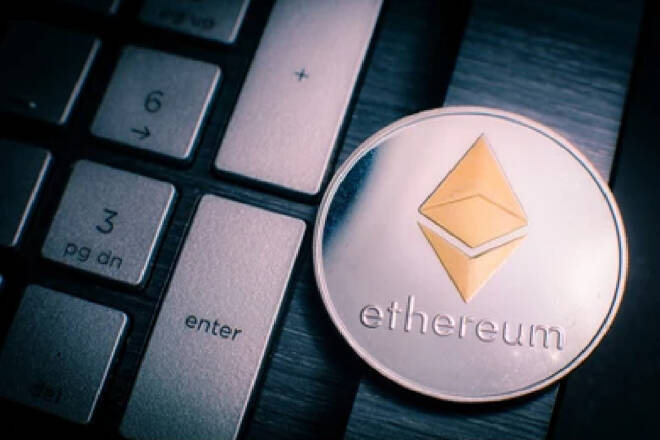Advertisement
Advertisement
ETH Bears to Retarget $1,800 on Gensler Comments and Fed Bets
By:
It is a busy day ahead for ETH and the broader market. While SEC and US lawmaker chatter will influence, US inflation numbers could fuel hawkish Fed bets.
Key Insights:
- ETH tracked the broader crypto market into the red on Thursday, falling 0.64% to end the day at $1,861.
- SEC Chair Gary Gensler overshadowed hotter-than-expected US GDP numbers that supported the soft-landing theory.
- The shorter-term technical indicators remain bearish, signaling a fall to sub-$1,800.
Ethereum (ETH) fell by 0.64% on Thursday. Partially reversing a 0.81% gain from Wednesday, ETH ended the day at $1,861. The bearish session left ETH short of $1,900 for the fourth consecutive session.
Ethereum Price Action
This morning, ETH was up 0.11% to $1,864. A range-bound start to the day saw ETH rise to an early high of $1,865 before easing back.
Daily Chart
The Daily Chart showed ETH hovering below the $1,895 – $1,865 support band. ETH also sat below the 50-day EMA ($1,871), while holding above the 200-day EMA ($1,780), sending bearish near-term but bullish longer-term price signals. Notably, the 50-day EMA narrowed on the 200-day EMA, a bearish price signal.
Looking at the 14-Daily RSI, the 46.87 reading sends a bearish outlook, signaling a fall through the $1,815 – $1,795 support band to target the 200-day EMA ($1,780). However, an ETH move through the 50-day EMA ($1,871) would support a breakout from the $1,865 – $1,895 support band to target $1,950.
4-Hourly Chart
Looking at the 4-Hourly Chart, the ETH/USD faces strong resistance at $1,875. ETH sits at the lower level of the $1,895 – $1,865 support band. However, ETH remained below the 50-day ($1,875) and 200-day ($1,880) EMAs, sending bearish near and longer-term price signals.
An ETH move through the EMAs and the $1,895 – $1,865 support band would give the bulls a run at $1,950.
The 14-4H RSI reading of 46.75 sends bearish ETH price signals, with selling pressure outweighing buying pressure. Significantly, the RSI aligns with the EMAs, supporting a run at the $1,815 – $1,795 support band.
SEC Chair Gary Gensler Creates Spot BTC ETF Approval Uncertainty
SEC Chair Gary Gensler was back in front of a camera, giving an interview to Bloomberg. The SEC Chair had this to say about crypto investing,
“This field of crypto investing, a lot of investors should be aware it’s not only a highly speculative asset class. It’s also one that they currently should not assume that they’re getting the protections of the securities laws even though the securities laws apply to many of those tokens without prejudging…”
Gensler went on to say,
“The platforms often are comingling and trading against you and have market makers on the other side of the trades. This is a field rife with fraud, rife with hucksters, and there are good faith actors as well but there are far too many that aren’t.”
On the issue of an SEC appeal, Gensler said that a discussion would take place should staff make a recommendation.
The comments raised uncertainty about the willingness of the SEC to approve the pending spot BTC ETF applications. ETH has fallen back from the $1,900 handle as investors grapple with the implications of the SEC v Ripple Court ruling on the SEC view of spot BTC ETFs.
Investors expect ETH ETFs to follow the launch of spot BTC ETFs.
Better-than-expected economic indicators from the US failed to influence despite US GDP numbers supporting the soft-landing theory. Later today, US Core PCE Price Index numbers could refuel bets on a September Fed rate hike, a bearish price scenario.
Staking Statistics Continue to Send Bullish Price Signals
According to CryptoQuant, staking inflows increased from 61,088 ETH on Wednesday to 63,104 on Thursday. While staking inflows remained below the 100,000 threshold, staking inflows were elevated.
The overnight withdrawal profile was bullish, with principal withdrawals at normal levels. However, withdrawal projections for the morning session are moderately bearish. Projections show ETH withdrawals will rise to above-normal withdrawal levels before easing back.
On Thursday, the net ETH staking balance stood at a 59,110 ETH surplus ($109.49 million), down 43.79% over 24 hours. Deposits totaled 66,300 versus withdrawals of 7,200 ETH.
According to TokenUnlocks, total pending withdrawals stood at 42,060 ETH, equivalent to approximately $78.38 million. Notably, the staking APR stood at 5.81%, up 0.35% over 24 hours. The staking APR upward trend and elevated staking inflows support ETH at current price levels.
About the Author
Bob Masonauthor
With over 28 years of experience in the financial industry, Bob has worked with various global rating agencies and multinational banks. Currently he is covering currencies, commodities, alternative asset classes and global equities, focusing mostly on European and Asian markets.
Advertisement
